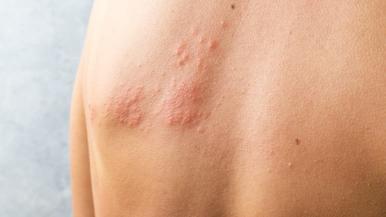Most Americans of a certain age remember the misery of chickenpox when they were children. But many of us don’t know a lot about shingles, its nasty older cousin. It can be serious — and seriously uncomfortable.
“Having shingles can be really unpleasant,” says Janet Furman, PA-C, “but if you recognize the typical signs, early treatment can help.”
We talked with Furman to learn five essential facts about shingles.
1. Shingles is the same virus as chickenpox
Shingles is a reactivation of the chickenpox virus, or varicella zoster virus. Once you have chickenpox, the virus becomes dormant but can reactivate years later and cause shingles.
People over age 50 or those who have compromised immune systems are at an increased risk for developing shingles, but anyone who has had chickenpox can get the disease.
2. Shingles typically occurs on one side of the body
Shingles typically appears as a blistery rash on one side of the body. The rash consists of red areas of skin with small blisters on the surface. The rash most commonly occurs in a linear area (like a stripe) and occurs most often on the torso or lower back.
Common symptoms include itching, pain at the rash site before the rash appears (called prodrome), as well as fever, chills, malaise (a general feeling of illness), headache and swollen glands.
3. Shingles can be serious
Shingles can often be very painful, and Furman says the commonly prescribed antiviral medication is most effective if it is started within 72 hours of your symptoms — so be sure to reach out to a provider if you are concerned you have shingles. The medication may not make the rash disappear, but it should shorten and reduce your symptoms overall.
If you have shingles on your head, face, or inside your mouth or nose you should be seen in the emergency department immediately to avoid complications. Shingles involving the eyes can lead to vision loss, and — rarely — shingles can result in hearing loss, pneumonia or serious illness. Some patients may experience pain, sensitivity or numbness in the rash area even after it goes away (this is called post-herpetic neuralgia).
And yes, it can be contagious.
“People who have not had chickenpox or have not been vaccinated for it can actually get it from a patient with shingles,” Furman says. Lesions are considered contagious until they have crusted over, and direct contact with shingles lesions should be avoided.
4. You can get treatment for shingles virtually
Treatment for shingles most commonly consists of over-the-counter medications for pain relief or a prescribed antiviral medication. You can also get treatment for shingles through a primary care provider or an E-Visit.
For an E-Visit, you should upload at least three well-lit and in-focus photos of the rash. Your virtual provider will assess your symptoms, prescribe medication if appropriate and advise you on how best to manage your symptoms at home.
“If you have a fever or severe symptoms,” Furman says, “a video visit may be more appropriate so you can discuss all of your symptoms with a provider.” You should avoid scratching or touching the rash and keep the area clean and dry. Calamine lotion and other topical anti-itch treatments may not be effective against shingles.
5. Shingles can be prevented
Luckily, there is a vaccine for shingles that can help prevent you from ever getting it at all. The CDC recommends patients over age 50 receive the shingles vaccine, regardless of past infection with or vaccination for chickenpox. If you have active shingles or are pregnant, you should wait before getting the shingles vaccine.
People born after 1995 may have gotten the chickenpox vaccine and may not have ever had chickenpox, but because immunity can wane as we age, they may still be able to get shingles later in life and should still get the shingles vaccine as recommended by their provider. Patients ages 19 and up with compromised immune systems should also discuss the shingles vaccine with their provider.
The shingles vaccine may cause mild to moderate side effects (such as pain at the injection site, or fatigue, chills and nausea), but they typically only last two to three days and go away on their own, and some people do not experience any side effects at all.





